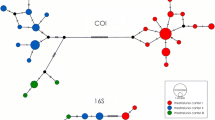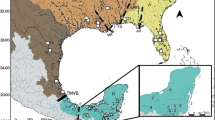Abstract
Foskett Spring is a small isolated desert spring in the Warner Basin of Oregon containing an undescribed subspecies of speckled dace protected under the US Endangered Species Act. Uncertainty regarding the taxonomic status of Foskett dace has raised questions about their evolutionary relationship to other more abundant populations in the Warner Basin. To address these questions, we sequenced 1,982 base pairs (bp) of the ND2 and cyt-b genes of mitochondrial DNA (mtDNA) for 85 fish from Foskett Spring, the surrounding Warner Basin, and the adjacent Goose Lake Basin. We observed 58 unique mtDNA haplotypes defined by 96 bp substitutions in both genes. MtDNA sequences were highly divergent and reciprocally monophyletic between dace from the Warner and Goose Lake Basins, with sequence divergences (5 and 3% at ND2 and cyt-b, respectively) in the range usually observed between fish species. In contrast, mean sequence divergence between Foskett dace and other Warner Basin populations was less than 1%, with no evidence of reciprocal monophyly among mtDNA lineages. These results indicate that Foskett dace and other populations in the Warner Basin are approximately equally diverged from one another evolutionarily, suggesting similar times of divergence since the late Pleistocene. We believe further studies are needed to determine if rapid evolution of novel traits have occurred in dace inhabiting the unique ecological setting of Foskett Spring during the past 10,000 years.






Similar content being viewed by others
References
Avise JC (2000) Phylogeography. Harvard University Press, Boston
Bernatchez L (1995) A role for molecular systematics in defining evolutionary significant units in fishes. Am Fish Soc Symp 17:114–132
Clement M, Posada D, Crandall KA (2000) TCS: a computer program to estimate gene genealogies. Mol Ecol 9:1657–1659
Dowling TE, Tibbetts AC, Minckley WL, Smith GR (2002) Evolutionary relationships of the Plagopterins (Teleostei: Cyprinidae) from Cytochrome b sequences. Copeia 2002:665–678
Excoffier L, Smouse PE, Quattro JM (1992) Analysis of molecular variance inferred from metric distances among DNA haplotypes: application to human mitochondrial DNA restriction data. Genetics 131:479–491
Excoffier L, Laval G, Schneider S (2005) ARLEQUIN, version 3.0: an integrated software package for population genetics data analysis. Evol Bioinform Online 1(4):7–50
Felsenstein J (1985) Confidence limits on phylogenies: an approach using the bootstrap. Evol Int J org Evol 39:783–791
Fry AJ, Zink RM (1998) Geographic analysis of nucleotide diversity and song sparrow (Aves: Emberizidae) population history. Mol Ecol 7:1303–1313
Fu Y-X (1997) Statistical tests of neutrality against population growth, hitchhiking, and background selection. Genetics 147:915–925
Gould WR, Kaya CM (1991) Pharynegeal teeth in the endangered Kendall Warm Springs dace (Rhinichthys osculus thermalis). Copeia 1991:227–229
Haig SM, Beever EA, Chambers SM, Draheim HM, Dugger BD, Dunham S, Elliott-Smith E, Fontaine JB, Kesler DC, Knaus BJ, Lopes IF, Loschl P, Mullins TD, Sheffield LM (2006) Taxonomic considerations in listing subspecies under the US Endangered Species Act. Conserv Biol 20(6):1584–1594
Harpending RC (1994) Signature of ancient population growth in a low-resolution mitochondrial DNA mismatch distribution. Hum Biol 66:591–600
Hedrick PW, Lee RN, Hurt CR (2006) The endangered Sonoran topminnow: examination of the species and ESUs using three mtDNA genes. Conserv Genet 7:483–492
Hubbs CL, Kuhne ER (1937) A new fish of the genus Apocope from a Wyoming warm spring. Occas Pap Mus Zool Univ Mich 343:1–21
Hubbs CL, Miller RR, Hubbs LC (1974) Hydrographic history and relict fishes of the north-central Great Basin. Calif Acad Sci Mem 7:1–259
Huelsenbeck JP, Ronquist F (2001) MrBayes: Bayesian inferences of phylogeny. Bioinformatics 17:754–755
Johnson JB (2002) Evolution after the flood: phylogeography of the desert fish Utah chub. Evol Int J org Evol 56(5):948–960
Johnson JB, Belk MC (1999) Effects of predation on life-history evolution in Utah chub (Gila atraria). Copeia 1999:948–957
Johnson JA, Dunn PO, Bouzat JL (2007) Effects of recent population bottlenecks on reconstructing the demographic history of prairie-chickens. Mol Ecol 16(11):2203–2222
Kaya CM, Brussard PF, Cameron DG, Vyse ER (1992) Biochemical genetics and thermal tolerances of Kendall Warm Springs dace (Rhinichthys osculus thermalis) and the Green River speckled dace (R. o. yarrowi). Copeia 1992:528–535
Kumar S (1996) PHYLTEST: Phylogenetic hypothesis testing software, version 2.0. Pennsylvania State University, University Park
Kumar S, Tamura K, Jakobsen IB, Nei M (2001) MEGA2: Molecular evolutionary genetics analysis software. Arizona State University, Tempe
Lee DS, Gilbert CR, Hocutt CH, Jenkins RE, McAllister DE, Stauffer JR (1980) Atlas of North American freshwater fishes. North Carolina Museum of Natural History, Releigh
McCusker MR, Parkinson E, Taylor EB (2000) Mitochondrial DNA variation in rainbow trout (Oncorhynchis mykiss) across its native range: testing biographical hypotheses and their relevance to conservation. Mol Ecol 9:2089–2108
Minckley WL, Hendrickson DA, Bond CE (1986) Geography of western North American freshwater fishes: description and relationships to intracontinential tectonism. In: Hocutt CH, Wiley EO (eds) The zoogeography of North American freshwater fishes. Wiley, New York, pp 519–614
Moyle PB (2002) Inland fishes of California. University of California Press, Berkley
Nei M (1987) Molecular evolutionary genetics. Middle Columbia University Press, New York
Nei M, Kumar S (2000) Molecular evolution and phylogenetics. Oxford University Press, New York
Neigel JE, Avise JC (1986) Phylogenetic relationships of mitrochondrial DNA under various demographic models of speciation. In: Nevo E, Karlin S (eds) Evolutionary processes and theory. Academic Press, New York, pp 515–534
Oakey DD, Douglas ME, Douglas MR (2004) Small fish in a large landscape: Diversification of Rhinichthys osculus (Cyprinidae) in western North America. Copeia 2:207–221
Pfrender ME, Hicks J, Lynch M (2004) Biogeographic patterns and current distribution of molecular-genetic variation among populations of speckled dace, Rhinichthys osculus (Girard). Mol Phylogen Evol 30(3):490–502
Posada D, Crandell KA (1998) Modeltest: testing the model DNA substitution. Bioinformatics 14:817–818
Ramos-Onsins SE, Rozas J (2002) Statistical properties of new neutrality tests against population growth. Mol Biol Evol 19:2092–2100
Reheis M, Sarna-Wojcicki AM, Reynolds RL, Repenning CA, Mifflin MD (2002) Pliocene to middle Pleistocene lakes in the western Great Basin: ages and connections (pp 53–109). In: Hershler R, Madsen DB, Currey DR (eds) Great Basin Aquatic Systems History Smithsonian Contributions to Earth Sciences, vol 33, 405 pp
Rogers AR, Harpending H (1992) Population growth makes waves in the distribution of pairwise genetic differences. Mol Biol Evol 9:552–569
Rozas J, Sanchez-DelBarrio JC, Messeguer X, Rozas R (2003) DNA SP, DNA polymorphism analyses by the coalescent and other methods. Bioinformatics 19:2496–2497
Scheerer PD, Jacobs SE (2006) Hutton Spring Tui Chub & Foskett Spring Speckled Dace Investigations. Oregon Department of Fish and Wildlife. Fish Research Project E-2-37, Annual Progress Report, Corvallis
Schneider S, Excoffier L (1999) Estimation of past demographic parameters from the distribution of pairwise differences when the mutation rates vary among sites: application to human mitochondrial DNA. Genetics 152:1079–1089
Smith GR, Dowling T, Gobalet KW, Lugaski T, Shiazawa D, Evans RP (2002) Biogeography and timing of evolutionary events among Great Basin fishes (pp 175–234). In: Hershler R, Madsen DB, Currey DR (eds) Great Basin aquatic systems history, Smithsonian Contributions to Earth Sciences, vol 33, 405 pp
Stepine CA, Dillion AK, Brooks MJ, Chase KL, Hubers AN (1997) The evolution of blennioif fishes based on the analysis of mitochondrial 12S rDNA. In: Kocher TD, Stepien CA (eds) Molecular systematics of fishes. Academic, San Diego, pp 245–270
Swofford DL (1999) PAUP*. Phylogenetic analysis using parsimony (*and other methods). Version 4. Sinauer Associates, Sunderland
Swofford DL, Olsen GJ, Waddell PJ, Hillis DM (1996) Phylogenetic inference. In: Hillis DM, Mortiz C, Mable BK (eds) Molecular systematics, 2nd edn. Sinauer Associates, New York, pp 407–514
Tajima F (1989) Statistical method for testing the neutral mutation hypothesis by DNA polymorphism. Genetics 123:585–595
Taylor EB, Pollard S, Louie D (1999) Mitochondrial DNA variation in bull trout (Salvelinus confluentus) from northwestern North America: implications for zoogeography and conservation. Mol Ecol 8:1155–1170
Templeton AR, Crandall KA, Sing CF (1992) A cladistic analysis of phenotypic associations with haplotypes inferred from restriction endonuclease mapping and DNA sequence data. III. Cladogram estimation. Genetics 132:619–633
US Fish Wildlife Service (1985) Determination of threatened status for Hutton tui chub and Foskett speckled dace. Fed Regist 50:12302–12306
US Fish and Wildlife Service (1998) Recovery plan for the native fishes of the Warner Basin and Alkali Subbasin. Portland, 86 pp
Williams JE, Stern MA, Munhall AV, Anderson GA (1990) Conservation status of threatened fishes in the Warner Basin, Oregon. Great Basin Naturalist 50(3):243–248
Williams JE, Macdonald CA, Williams CD, Weeks H, Lampman G, Sada DW (2005) Prospects for recovering endemic fishes pursuant to the US Endangered Species Act. Fisheries 30(6):24–29
Zink RM (2004) The role of subspecies in obscuring avian biological diversity and misleading conservation policy. Proc R Soc Lond B Biol Sci 271(1539):561–564
Acknowledgments
Funding for this project was provided by the US Fish and Wildlife Service. D. Campton provided valuable input on development of this project. We would like to thank C. W. Kilpatrick, D. Markle, T. Dowling, M. Pfrender, and C. Hurt for assistance with laboratory methods and data analysis. J. Baumsteiger, C. Allen, R. White, A. Mauer, A. Munhall, and S. Reid collected samples used in this study. D. Campton, P. Crandell, D. Markle, and two anonymous reviewers provided critical review and comments that greatly improved this paper. The findings and conclusions in the article are those of the authors and do not necessarily represent the views of the US Fish and Wildlife Service.
Author information
Authors and Affiliations
Corresponding author
Rights and permissions
About this article
Cite this article
Ardren, W.R., Baumsteiger, J. & Allen, C.S. Genetic analysis and uncertain taxonomic status of threatened Foskett Spring speckled dace. Conserv Genet 11, 1299–1315 (2010). https://doi.org/10.1007/s10592-009-9959-0
Received:
Accepted:
Published:
Issue Date:
DOI: https://doi.org/10.1007/s10592-009-9959-0




